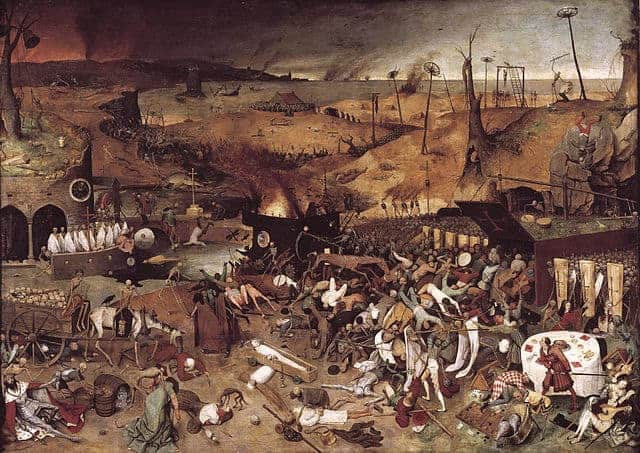Between 1347-1350, a unique and virulent form of plague devastated Europe. Spread from the east via the Mediterranean trade routes, within three years, what became known as the Black Death, Bubonic Plague or the Great Plague had swept across Europe? Fourteenth century society-already weakened by war and malnutrition was at its mercy. The pandemic was, relentlessly, switching between bubonic phases characterized by black and swollen buboes caused by inflamed lymph nodes, pneumonic plague, which attacked the lungs and septicaemic Plague. By the time its grip began to slacken in 1350, the Black Death had killed one-third of the European population were dead. It would take two hundred years for levels to recover.
The effects of the Black Death on European society during and after the pandemic were stark. The onset of the disease threw society into turmoil, overthrowing all the usual social, moral and religious mores, as people attempted to stay alive and cope with the everyday horror of their lives. This social turmoil did not cease once the plague was over. For the enormous losses of life changed the dynamics of European society, leading to alterations in the status quo between the classes, town and country and religion. Here are just ten ways in which the Black Death turned society upside down.

Towns and Cities sealed themselves off.
The plague began to change European society from the moment it touched land. It initially entered the European mainland via the Mediterranean ports. The Black Death’s first landing on European soil was at Messina in Sicily, October 1347. Fleas, rats, and sailors all carrying the plague disembarked before the port’s citizens realized they were infected. Within days, the disease had spread, and the desperate citizens of Messina drove the infected sailors back out to sea. However, it was too late to prevent the plagues spread. By January 1348, it had reached Genoa and Venice and then moved north to the northern city of Pisa.
The plague’s journey through Europe had begun- and news of its devastation preceded it. Those towns and cities as yet unaffected tried staving off infection by learning from the example of the plagues’ early victims. “A single stranger carried the infection to Padua, to such effect that perhaps a third of the people died within the region as a whole” noted L A Murtori writing of these fourteenth-century events three centuries later. “In the hope of avoiding such a plague, cities banned the entry of all outsiders.” So, when a city heard the plague was approaching, it quickly sealed its gates.
However, such measures could also be the ruin of towns, as trade would stop, destroying economic wealth. More importantly, once food supplies ran out, the whole population, wealthy or not, would starve. So other towns opted for a more limited form of quarantine. The English city of Gloucester had become prosperous due to its trade in cloth, iron, wine, and corn with Bristol along the River Severn. Annual and weekly fairs for the outlying districts also added to its wealth. Then, in the summer of 1348, news reached the town that the plague had infected the port of Bristol.
So, the council of Gloucester took the drastic decision to close itself off to- travelers from Bristol at least. By barring one of its primary sources of income, the town’s economy was at risk but the councilor’s hoped by banning contact with the infected city, they could keep the plague at bay- and continue to function. However, this measure did not reassure the town’s citizens. They began to flee Gloucester for the countryside where they believed they would be safe. Such was the extent of the exodus that the authorities began to issue a fine for each day a person was absent as they feared there would be insufficient people to run the town.
However, the council’s partial sealing of the city was insufficient. In 1349, the plague reached Gloucester. The people of Gloucester were about to discover, as had those who had encountered disease across Europe before them, that they were willing to abandon much more than their towns, wealth and possessions to stay alive.

